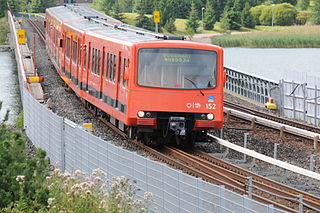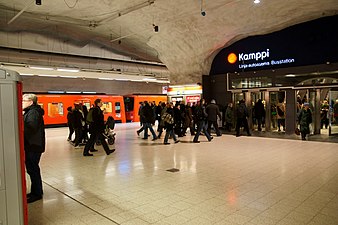
Helsinki is the capital and most populous city in Finland. It is located on the shore of the Gulf of Finland and serves as the seat of the Uusimaa region in southern Finland. Approximately 675,000 people live in the municipality, with 1.25 million in the capital region, and 1.58 million in the metropolitan area. As the most populous urban area in Finland, it is the country's most significant centre for politics, education, finance, culture, and research. Helsinki is situated 80 kilometres (50 mi) to the north of Tallinn, Estonia, 360 kilometres (220 mi) to the north of Riga, Latvia, 400 kilometres (250 mi) to the east of Stockholm, Sweden, and 300 kilometres (190 mi) to the west of Saint Petersburg, Russia. Helsinki has significant historical connections with these four cities.

The Helsinki Metropolitan Area Council was a co-operation agency operating in the Helsinki metropolitan area, now replaced by HSL and HSY. The organisation had a few responsibilities, most notably regional public transport and waste management. It was subordinated to the city councils of the four participating cities. Furthermore, transport cooperation also included neighboring municipalities of Kerava and Kirkkonummi.

The Helsinki Metro is a rapid transit system serving the Helsinki capital region, Finland. It is the world's northernmost metro system. It was opened to the general public on 2 August 1982 after 27 years of planning. It is operated by Helsinki City Transport and Metropolitan Area Transport Ltd for Helsinki Regional Transport Authority and carries 92.6 million passengers per year.

The Ring Rail Line is a railway route in the area of the city of Vantaa, in the Greater Helsinki Metropolitan Area of Finland. It connects Helsinki-Vantaa Airport and the adjacent Aviapolis business and retail district to the Helsinki commuter rail network. The line fills the gap between Vantaankoski and Tikkurila railway stations, travelling in tunnel underneath the airport.

Vuosaari metro station is the ground-level terminus station of the M1 line of the Helsinki Metro. It serves the district of Vuosaari in East Helsinki.

Länsimetro is an extension to the Helsinki Metro system in Finland, which opened on 18 November 2017. Länsimetro extends the system's two lines, M1 and M2, from Central Helsinki to the neighbouring city of Espoo. The new stretch continues the lines from the existing Ruoholahti station via the island of Lauttasaari, the Aalto University Otaniemi campus and Tapiola, the terminus of line M2. Line M1 continues further west to Matinkylä. Unlike previous extensions to the Helsinki Metro system, Länsimetro runs entirely underground. The second phase opened on 3 December 2022 and continues the line further west to Kivenlahti, near the municipal border of Kirkkonummi.

Pasila station is a railway station in Helsinki, Finland, approximately 3.5 kilometres (2.2 mi) north of Helsinki Central. It is the second busiest railway station in Finland, after Helsinki Central, and takes up a large part of the district of Pasila. The station was first opened in 1862 along the Finnish Main Line. The current station building opened in 2019.

Public transport in Helsinki consists of bus, tram, metro, local railway and ferry services. The system is managed by the Helsinki Regional Transport Authority and covers Helsinki, Espoo, Kauniainen, Vantaa and the outlying Kerava, Kirkkonummi, Sipoo and Tuusula.

The Helsinki Regional Transport Authority is the inter-municipal authority that maintains the public transportation network of the nine municipalities of Greater Helsinki, Finland.

Trams in Finland date from a horse-drawn Turku tramway network, which opened in 1890. Electric tramway traction started in Finland in 1900 with the introduction of electric trams in Helsinki, and the last horse-drawn trams were withdrawn from operation in 1917. Although there were three Finnish tramway networks between 1912 and World War II, by 1972 the number of networks had dwindled to just one, that of Helsinki, which remained Finland's only tramway network for almost 50 years. However, in August 2021, a light rail line was opened to the public in Tampere. There have also been proposals to set up tram or light rail networks in some other cities. As of 2021, the most concrete such plans are in Turku.

The Helsinki second metro line is a common name for planned extensions to the Helsinki Metro, intended to be developed after the Länsimetro extension has been completed.

Until 2021, Helsinki was Finland's only remaining city with tram traffic. Two other cities—Turku (see Turku tram) and Vyborg —have had tram systems. Vyborg abandoned its trams in 1957 after it was ceded to the Soviet Union after the end of World War II. Turku withdrew its trams in 1972.
The city of Helsinki and the neighbouring city of Vantaa have plans for a radical expansion of the Helsinki tram network within the 2020s and 2030s that would more than double the length of the network from 2021. If completed, the plans would both extend the current tram lines and build new light rail lines.

Helsinki City Bikes is a public bicycle system in Helsinki and Espoo and integrating with the rest of the public transport in Helsinki since May 2016. It is operated as a public-private partnership between Helsinki Regional Transport Authority (HSL), Helsinki City Transport (HKL), Espoo Technical and Environment Services, Moventia and Smoove.

Esa Erkki Piironen is a Finnish architect. He studied architecture at Helsinki University of Technology, qualifying as an architect in 1970. He studied architecture and urban design in North Carolina State University in Raleigh, North Carolina, and was awarded the Master of Architecture in 1972. He was working as a teaching assistant at Helsinki University of Technology 1972–81, and was awarded Licentiate in Technology in 1978. Visiting professor at Guangdong University of Technology School of Art and Design starting from 2012.

Helsinki light rail line 15 is a 25-kilometre (16 mi) light rail line connecting Keilaniemi in Espoo and Itäkeskus in Helsinki, Finland. Known during construction as Jokeri light rail, construction was started in June 2019 and the line began operating in October 2023, about 10 months ahead of the original schedule. The line replaced the trunk bus line 550, the busiest bus service on the Helsinki Regional Transport Authority public transport network, at the end of 2023.

The HKL Class M100 is the first and oldest class of metro trains in use on the Helsinki Metro. One train consists of two individually numbered cars. A total of 42 units were manufactured between 1977 and 1984.

The HKL Class M300 is a class of metro trains operated by Metropolitan Area Transport Ltd in use on the Helsinki Metro. 20 four-carriage trains were built between 2014 and 2016 by Construcciones y Auxiliar de Ferrocarriles for the Länsimetro extension. In November 2019, HKL announced the purchase of five additional trains, delivered in 2022.

Local and regional bus services are a large part of public transport in the Helsinki region. HSL bus services include internal services in Helsinki, Espoo, Kauniainen, Vantaa, Kerava, Kirkkonummi, Sipoo, Siuntio and Tuusula and regional services between them.

The Helsinki capital region is the area formed by the cities of Espoo, Helsinki, Kauniainen and Vantaa in Finland. The area is limited around Helsinki, the capital of Finland. The area is located in the southern part of Finland on the shores of the Gulf of Finland and is an important growth centre with a population of 1.25 million.


























